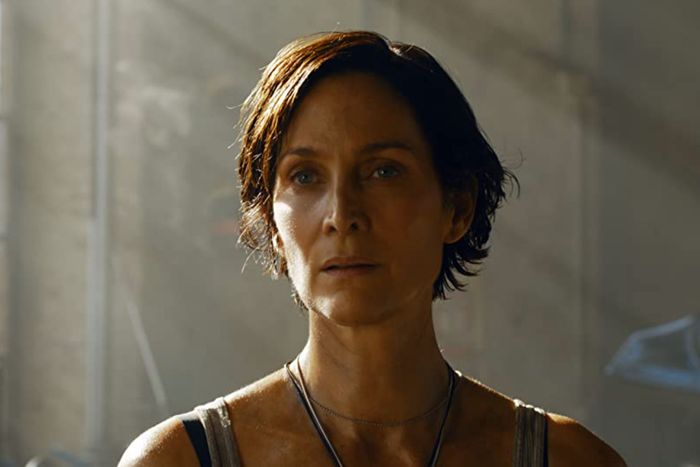
Almost two decades after the release of The Matrix Revolutions, Lana Wachowski, without her sister Lilly, returns to her humans-versus-machine cinematic universe with The Matrix Resurrections. Keanu Reeves’s homecoming as Neo — a sardonic meta-textual, romantic adventure replete with slow-motion fights and new companions — takes a unique path back into the Matrix mainframe. But this is a franchise installment, after all. So let’s talk about that ending and what it means for the future of the Matrix universe. Spoilers ahead.
First, a brief rundown of the machinations that get us there: In Resurrections, Reeves is Thomas Anderson, an award-winning game designer working for a man named Smith (Jonathan Groff); together, they created a successful video game called The Matrix. Unbeknownst to Anderson — who takes a blue medication prescribed to him by his analyst (Neil Patrick Harris) — he is actually the Neo of his game, and he and Trinity (a mother of two named Tiffany in this reality) have been resurrected in surrogate bodies and reinserted into the Matrix by Anderson’s analyst — the Analyst, the new Architect — who is actually a powerful computer program working for “the suits,” the machines who’ve kidnapped humanity.
And so a gunslinging, blue-haired captain named Bugs (Jessica Henwick), helped along by another powerful computer program dubbed Morpheus (Yahya Abdul-Mateen II), whisks Neo out of the Matrix simulation (that’s been running for 60 years now) and to the harmonious human-machine city of Io, where Neo sets his sights on freeing Trinity. Neo, Bugs, and Morpheus visit Sati (Priyanka Chopra Jonas), a program that first appeared to Neo as a child in the purgatorial train station of Revolutions. She has an idea; they just need to break into the machine tower where Trinity’s reconstituted body is to pull it off. So Neo returns to the Matrix to give the Analyst an ultimatum: If he reaches Trinity and she makes it clear she desires to stay in the simulation, he will return to the machines without a fight. If, however, she wants to leave, they’ll both be free.
The moment of truth occurs at night in a coffee shop named Simulatte. Neo explains to Trinity who she is, and while there’s some doubt on her part, particularly when the Analyst sends in her fake husband and children to try to pull her away, she does indeed awaken, and it’s Neo and Trinity against the world again — more specifically, against Smith, née Agent Smith, and the Analyst. Smith, after having momentarily allied with Neo, has a seemingly innocuous line here — “You know what the difference is between you and me?” — familiar to those who’ve watched the Wachowskis’ debut film, the lesbian neo-noir thriller Bound, in which Corky asks the same thing. The answer, for Smith: “Anyone could have been you, but I’ve always been anyone.”
Without access to a red pill, Bugs joins minds with Trinity in order to guide her out of the Matrix, and for a split second Trinity inhabits the body of Tiffany and Bugs. During the ensuing mêlée between our heroes and the villainous programs, Neo and Trinity drive a Ducati, leap from buildings, and endure a helicopter explosion atop a skyscraper (an obvious callback to the first movie) that temporarily renders them unconscious. When Trinity finally opens her eyes, she sees a gold-kissed sky and the murmuration of birds, a repeating motif in the film. It’s likely repetitive code, a glitch in the Matrix alerting keen observers to the artificiality of this simulated world. For Trinity, it’s another awakening, akin to that distant scene in a hallway, when Neo arose to see the world in code.
Wachowski loves leaps of faith, whether from the rooftop of a skyscraper in simulation or simply into love. In Resurrections, Neo is the one falling and it’s Trinity who catches him midair before the pair fly away, raising the question: Who is the one flying? In the previous Matrix films, Neo and Agent Smith are the only characters who can fly, a nod to their yin-and-yang existence. As the Architect explains to Neo in The Matrix Reloaded, he is the remainder in an equation, and Smith exists to balance that equation. Wachowski revisits the math in Resurrections and cracks open the Messiah mythology of The Matrix franchise, too. According to the Analyst, neither she nor Neo are all that special on their own. But together, they create the concept of “the One.” And so Trinity transitions from devoted spouse to a universal counterbalance: a true soul mate. Like in the Wachowskis’ Cloud Atlas and Jupiter Ascending, the building blocks of sci-fi epics are romance and fate.
After their triumphant flight, Neo and Trinity, clad in all-black leather and shades, visit the Analyst in the Matrix again. He tells them they can turn the sky to rainbows for all he cares (the joke is a reference to the end of Revolutions, when Sati created a multicolored sky in homage to Neo’s sacrifice), but their battle isn’t over. We already know that the peace Neo brokered at the end of Revolutions resulted in the present-day union between programs, machines, and humans in Io. But how strong is that partnership? Maybe as Niobe (Jada Pinkett Smith), now the leader of Io, tells Neo, the sounds of war are stirring again. As the pair fly away once more, the needle drop is Rage Against the Machine’s song “Wake Up.” And just like that, a door for more sequels opens.




